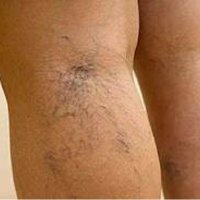Laparoscopy: what is it, the pros and cons of laparoscopy of the abdominal organs
 Surgeons like to repeat: "The stomach is not a suitcase, it can not just be opened and closed" .Indeed, surgical operations on the abdominal organs are traumatic, full of risks and negative consequences.Therefore, when laparoscopic method of treatment of surgical diseases was invented by bright heads - doctors and patients sighed with relief.
Surgeons like to repeat: "The stomach is not a suitcase, it can not just be opened and closed" .Indeed, surgical operations on the abdominal organs are traumatic, full of risks and negative consequences.Therefore, when laparoscopic method of treatment of surgical diseases was invented by bright heads - doctors and patients sighed with relief.
What is laparoscopy
Laparoscopy - this is the introduction into the cavity of the abdomen through small( slightly more than one centimeter in diameter) Holes, when the hands and eyes of the surgeon are the laparoscope, which is inserted into the cavity through these holes.
The main parts of the laparoscope are :
-
 telescopic tube;
telescopic tube; - lens kit;
- camcorder;
- optical cable with backlight( in its quality stands a miniature halogen or xenon lamp).
The tube serves as a kind of pioneer, which is carefully introduced into the abdominal cavity.Through it, the surgeon looks at what is being done in the inner kingdom of the abdomen, through another hole introduces a surgical instrumentation, through which performs a number of surgical manipulations in the abdominal cavity.At the end of the laparoscope tube, which is inserted into the abdominal cavity, a small video camera is attached.With its help, the image of the abdominal cavity is transmitted from the inside to the screen.
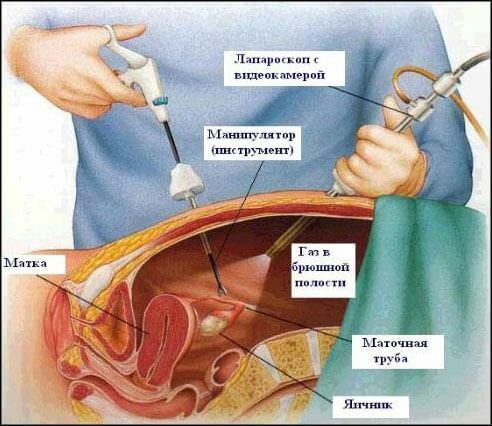
word "laparoscopy" reflects the essence of this method: from the Greek "lapar" means "belly belly", "Skopje" - "inspection". operation via laparoscope properly be called laparotomy( from the Greek "tomy" - section, excision), but the term "laparoscopy" has taken root and used to this day.
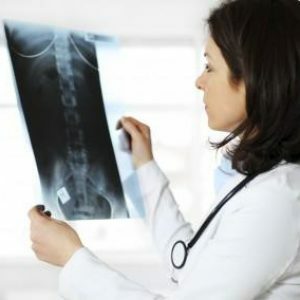 It should be noted that laparoscopy is not only the operation "through the tube", but also the detection of diseases of the abdominal cavity .After painting the abdomen with all its entrails, which can be seen by the eye( even through the optical system) is more informative than the "encrypted" the images obtained, for example, with X-ray, ultrasound or computed tomography - they still need to be interpreted.
It should be noted that laparoscopy is not only the operation "through the tube", but also the detection of diseases of the abdominal cavity .After painting the abdomen with all its entrails, which can be seen by the eye( even through the optical system) is more informative than the "encrypted" the images obtained, for example, with X-ray, ultrasound or computed tomography - they still need to be interpreted.
Scheme of the laparoscopic treatment
With laparoscopy, the manipulation algorithm is greatly simplified.No need to perform complex, both in the open method of operation, access to the abdominal cavity( in the traditional surgery it is often delayed in time because of the need to stop bleeding from injured blood vessels, due to the presence of scar adhesions and so on).Also, you do not need to spend time on layer-by-layer stitching of the postoperative wound.
Scheme of laparoscopy next :
-
 treatment of the operation field;
treatment of the operation field; - pricking the anterior abdominal wall with a trocar;
- introduction to the abdominal cavity of the laparoscope;
- injection into the abdomen of the stomach of dry gases, due to which the front abdominal apparatus rises above the internal organs, their review becomes better;
- examination of the abdominal organs;
- introduction to the cavity of the manipulator( toolkit);
- performing the necessary manipulations;
- extraction of laparoscope and instrumentation;
- sewing holes;
- application of an aseptic dressing.
range of diseases that are treated by laparoscopy, a fairly wide :
-
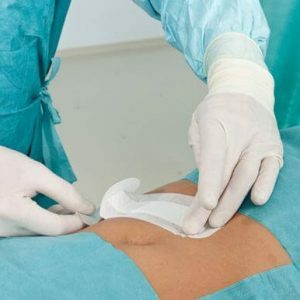 appendectomy;
appendectomy; - cholecystectomy( gallbladder removal);
- hernioplasty( suturing an anatomical defect, due to which a hernia is formed);
- gastrectomy( complete removal of the stomach);
- pancreatoduodenal resection( removal of a fragment of the pancreas, parts of the duodenum, stomach and gallbladder);
- operations on the small and large intestine;
- surgery for tumors of the abdominal cavity;
and many other surgical pathologies.
Advantages of laparoscopy
Because, unlike the open surgical procedure, you do not need to make large incisions for examination and manipulation in the abdomen, the "pluses" of laparoscopy are significant :
-
 reduction in the trauma of the anterior abdominal wallThe usual operation of the incision can reach 25-30 centimeters in length, and in some cases even more);
reduction in the trauma of the anterior abdominal wallThe usual operation of the incision can reach 25-30 centimeters in length, and in some cases even more); - reduction of abdominal injuries( laparoscope tube, having a small diameter, can neatly "glance" in the most remote corners and "pockets" of - which is not observed with the open method, when for the best visualization the body has to fiddle, twist in the hands andOffset);
- improved visualization( unlike the human eye, which is capable of changing the focus, the laparcopy system can magnify the image up to 40 times);
- due to the reduction of trauma - reduction in the length of stay of patients in the hospital( on average up to 1 week, whereas with the open method the length of stay in the clinic can last up to several weeks);
- almost perfect cosmetic effect - after laparoscopy, small scars remain( up to 1.5 centimeters), while after normal operation, unaesthetic thick scars may remain, not to mention that sometimes a postoperative wound heals longer than usual.
Lacaroscopy deficiencies
The laparoscopic method has made, without exaggeration, a revolutionary upsurge in abdominal surgery.Nevertheless, it is not 100% perfect and has a number of shortcomings. There are often clinical cases when, having started laparoscopy, surgeons were not satisfied with it and had to switch to an open surgical procedure.
The main disadvantages of laparoscopy are the following :
- because of observation through the optics, the perception of depth is distorted, and a significant experience is needed so that the surgeon's brain correctly calculates the true depth of laparoscope insertion;
- The laparoscope tube does not have such flexibility as the fingers of the surgeon, the laparoscope is somewhat sluggish, and this limits the range of manipulations;
- because of the lack of tactile sensation it is impossible to calculate the force of the device's pressure on the tissue( for example, clamping the tissues with a clamp);
- it is impossible to determine some characteristics of internal organs - for example, the consistency and density of tissues in a tumor disease, which can be assessed only by palpation;
- there is a sharpness of the picture - at some particular moment the surgeon sees in the laparoscope only a specific area of the abdominal cavity and can not visualize it as a whole, as with the open method.
Possible complications for laparoscopic treatment
They are significantly less than with an open surgical procedure.Nevertheless, one must remember the risks.
The most common complications during laparoscopy are :
- damage to the blood vessels and intestines with a trocar( a surgeon's tool similar to a thick screwdriver - they gently pierce the anterior abdominal wall so that a laparoscope is inserted into the abdominal cavity through the hole);
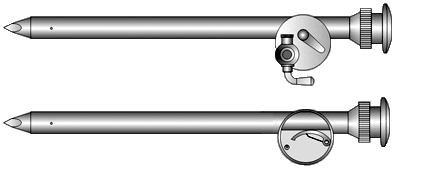
- Subcooling of tissues due to excessive introduction into the abdominal cavity of cold dry gases that inflate the stomach and thereby improve the visibility of internal organs;
- pressure of the same gases on the diaphragm and chest cavity, which is poorly tolerated by patients with pulmonary diseases;
- burns electrodes, which are used for electrocoagulation( electrocution action on tissue to stop bleeding from small vessels).
Advances in laparoscopy
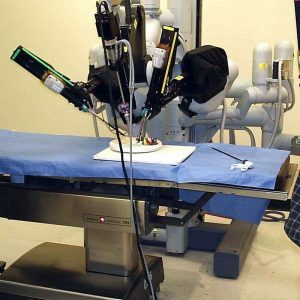 The laparoscopic method is not only considered the most progressive in abdominal surgery - it is constantly evolving.So, developers have created a clever robot equipped with microtools, which are much smaller than the standard laparoscopic instruments.The surgeon sees on the screen a 3D image of the abdominal cavity, uses joysticks to give commands, the robot analyzes them and instantly turns into jewelry movements the micro-instruments inserted into the abdominal cavity.Thus, the precision of manipulation is increased several times - like a real living surgeon, but of a reduced size, climbed through a small hole in the abdominal cavity and performs all necessary manipulations with reduced hands.
The laparoscopic method is not only considered the most progressive in abdominal surgery - it is constantly evolving.So, developers have created a clever robot equipped with microtools, which are much smaller than the standard laparoscopic instruments.The surgeon sees on the screen a 3D image of the abdominal cavity, uses joysticks to give commands, the robot analyzes them and instantly turns into jewelry movements the micro-instruments inserted into the abdominal cavity.Thus, the precision of manipulation is increased several times - like a real living surgeon, but of a reduced size, climbed through a small hole in the abdominal cavity and performs all necessary manipulations with reduced hands.
Thanks to the very high precision of the operation, is one of the most famous laparoscopic robot surgeons( it has four arms by the way), it has the name "da Vinchi" - named after Leonardo da Vinci, one of the most well-known mankind and lightGoals.
Kovtonyuk Oksana Vladimirovna, medical reviewer, surgeon, consulting physician



